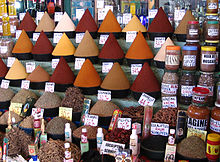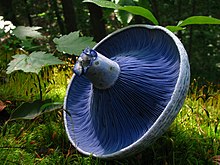Portal:Food
F o o d
A portal dedicated to food and foodways
Introduction


Food is any substance consumed by an organism for nutritional support. Food is usually of plant, animal, or fungal origin and contains essential nutrients such as carbohydrates, fats, proteins, vitamins, or minerals. The substance is ingested by an organism and assimilated by the organism's cells to provide energy, maintain life, or stimulate growth. Different species of animals have different feeding behaviours that satisfy the needs of their metabolisms and have evolved to fill a specific ecological niche within specific geographical contexts.
Omnivorous humans are highly adaptable and have adapted to obtain food in many different ecosystems. Humans generally use cooking to prepare food for consumption. The majority of the food energy required is supplied by the industrial food industry, which produces food through intensive agriculture and distributes it through complex food processing and food distribution systems. This system of conventional agriculture relies heavily on fossil fuels, which means that the food and agricultural systems are one of the major contributors to climate change, accounting for as much as 37% of total greenhouse gas emissions. (Full article...)
Cooking, also known as cookery or professionally as the culinary arts, is the art, science and craft of using heat to make food more palatable, digestible, nutritious, or safe. Cooking techniques and ingredients vary widely, from grilling food over an open fire, to using electric stoves, to baking in various types of ovens, reflecting local conditions. Cooking is an aspect of all human societies and a cultural universal.
Preparing food with heat or fire is an activity unique to humans. Archeological evidence of cooking fires from at least 300,000 years ago exists, but some estimate that humans started cooking up to 2 million years ago.
The expansion of agriculture, commerce, trade, and transportation between civilizations in different regions offered cooks many new ingredients. New inventions and technologies, such as the invention of pottery for holding and boiling of water, expanded cooking techniques. Some modern cooks apply advanced scientific techniques to food preparation to further enhance the flavor of the dish served. (Full article...)
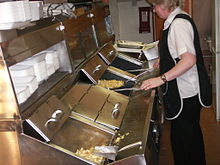
Deep frying (also referred to as deep fat frying) is a cooking method in which food is submerged in hot fat, traditionally lard but today most commonly oil, as opposed to the shallow frying used in conventional frying done in a frying pan. Normally, a deep fryer or chip pan is used for this; industrially, a pressure fryer or vacuum fryer may be used. Deep frying may also be performed using oil that is heated in a pot. Deep frying is classified as a hot-fat cooking method. Typically, deep frying foods cook quickly since oil has a high rate of heat conduction and all sides of the food are cooked simultaneously.
The term "deep frying" and many modern deep-fried foods were not invented until the 19th century, but the practice has been around for millennia. Early records and cookbooks suggest that the practice began in certain European countries before other countries adopted the practice. (Full article...)
Selected article –

Conversations regarding the ethics of eating meat are focused on whether or not it is moral to eat non-human animals. Ultimately, this is a debate that has been ongoing for millennia, and it remains one of the most prominent topics in food ethics. Individuals who promote meat consumption do so for a number of reasons, such as health, cultural traditions, religious beliefs, and scientific arguments that support the practice. Those who support meat consumption typically argue that making a meat-free diet mandatory would be wrong because it fails to consider the individual nutritional needs of humans at various stages of life, fails to account for biological differences between the sexes, ignores the reality of human evolution, ignores various cultural considerations, or because it would limit the adaptability of the human species.
People who abstain from eating meat are generally known as "vegetarians". They avoid meat for various reasons such as taste preferences, religion, animal welfare, the environmental impact of meat production (environmental vegetarianism), health considerations, and antimicrobial resistance. Vegans also abstain from other animal products, such as dairy products, honey and eggs, for similar reasons. "Ethical omnivores" are individuals who object to the practices underlying the production of meat, as opposed to the act of consuming meat itself. In this respect, many people who abstain from certain kinds of meat eating and animal products do not take issue with meat consumption in general, provided that the meat and animal products are produced in a specific manner. Ethical omnivores may object to rearing animals for meat in factory farms, killing animals in ways that cause pain, and feeding animals unnecessary antibiotics or hormones. To this end, they may avoid meats such as veal, foie gras, meat from animals that were not free range, animals that were fed antibiotics or hormones, etc. (Full article...)Selected cuisine -
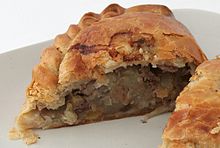
Cornish cuisine encompasses the cooking styles, traditions and recipes associated with Cornwall and the Cornish people. It has been heavily influenced by the geography of the county as well as its social history.
Cornwall, being a peninsula surrounded by seas historically well-stocked with fish, has meant that fish dishes form a major part of the historical and modern recipes in Cornwall. The fishing industry has played a major part in the economy of the county. The iconic dish of Cornwall, the pasty, has its roots in another historical industry within the county, this being mining. (Full article...)Selected ingredient –
In the culinary arts, a spice is any seed, fruit, root, bark, or other plant substance in a form primarily used for flavoring or coloring food. Spices are distinguished from herbs, which are the leaves, flowers, or stems of plants used for flavoring or as a garnish. Spices are sometimes used in medicine, religious rituals, cosmetics, or perfume production. They are usually classified into spices, spice seeds, and herbal categories.For example, vanilla is commonly used as an ingredient in fragrance manufacturing. Plant-based sweeteners such as sugar are not considered spices.
Spices may be used fresh and whole, after drying, grating, chopping, crushing, or grinding, or by extraction into a tincture. Such processing may happen before a spice is offered for sale, while preparing a dish in a kitchen, or after a dish has been presented for consumption (such as peppercorns ground at the table as a condiment). Some spices such as turmeric are seldom available either fresh or whole and so must be purchased in ground form. Small seeds such as fennel or mustard may be used either whole or in powdered form. (Full article...)
Selected recipe –
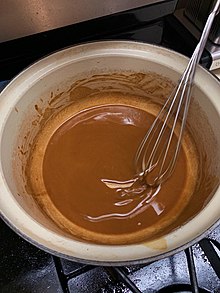
Roux (/ruː/) is a mixture of flour and fat cooked together and used to thicken sauces. Roux is typically made from equal parts of flour and fat by weight. The flour is added to the melted fat or oil on the stove top, blended until smooth, and cooked to the desired level of brownness. A roux can be white, blond (darker) or brown. Butter, bacon drippings or lard are commonly used fats. Roux is used as a thickening agent for gravy, sauces, soups and stews. It provides the base for a dish, and other ingredients are added after the roux is complete. (Full article...)
Lactarius indigo, commonly known as the indigo milk cap, indigo milky, the indigo (or blue) lactarius, or the blue milk mushroom, is a species of agaric fungus in the family Russulaceae. It is a widely distributed species, growing naturally in eastern North America, East Asia, and Central America; it has also been reported in southern France. L. indigo grows on the ground in both deciduous and coniferous forests, where it forms mycorrhizal associations with a broad range of trees. The fruit body color ranges from dark blue in fresh specimens to pale blue-gray in older ones. The milk, or latex, that oozes when the mushroom tissue is cut or broken — a feature common to all members of the genus Lactarius — is also indigo blue, but slowly turns green upon exposure to air. The cap has a diameter of 5–15 cm (2–6 in), and the stem is 2–8 cm (0.8–3 in) tall and 1–2.5 cm (0.4–1.0 in) thick. It is an edible mushroom, and is sold in rural markets in China, Guatemala, and Mexico. In Honduras, the mushroom is called a chora, and is generally eaten with egg; generally as a side dish for a bigger meal. (Full article...)
Selected image –
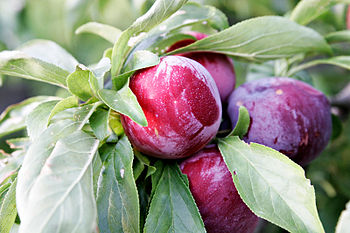
Selected biography –
B. 27 May 1975
Jamie Trevor Oliver MBE OSI (born 27 May 1975) is an English celebrity chef, former restaurateur and cookbook author. He is known for his casual approach to cuisine, which has led him to front numerous television shows and open many restaurants.
Oliver reached the public eye when his series The Naked Chef premiered in 1999. In 2005, he opened a campaign, Feed Me Better, to introduce schoolchildren to healthier foods, which was later backed by the government. He was the owner of a restaurant chain, Jamie Oliver Restaurant Group, which opened its first restaurant, Jamie's Italian, in Oxford in 2008. The chain went into administration in May 2019. (Full article...)
Did you know (auto-generated) –

- ... that after George Alexander Albrecht collapsed when conducting Beethoven's Ninth Symphony during a New Year's concert, he returned to composing and began hospice work?
- ... that the reactions to food depicted in the manga series Food Wars!: Shokugeki no Soma were decided on through free association games?
- ... that Kenneth Lo was called "the foremost expert in Britain on Chinese food"?
- ... that Foodbank Canterbury receives products from a prison?
- ... that agronomist Simon Groot was awarded the 2019 World Food Prize for "benefiting hundreds of millions of consumers with greater access to nutritious vegetables"?
- ... that not all military rations are food?
More did you know –
Related portals
Food topics
The following are topics relating to food
Categories
Food list articles
- See also: Lists of foods and Category:Lists of drinks
The following are some Food list articles on Wikipedia:

- American cheeses
- Appellation d'Origine Contrôlée cheeses
- Apple cultivars
- Bacon dishes
- Bacon substitutes
- Basil cultivars
- Breads
- Breakfast beverages
- Breakfast cereals
- Breakfast foods
- British cheeses
- Cakes
- Candies
- Cheeses
- Cheese soups
- Christmas dishes (list)
- Cocktails
- Cookies
- Dishes using coconut milk
- Diets
- Doughnut varieties
- Egg dishes
- Fermented soy products
- Food additives
- Food additives (Codex Alimentarius)
- Foods named after people
- French cheeses
- French dishes
- Fried dough foods
- Fruits
- List of hamburgers
- Herbs and spices
- Hors d'oeuvre
- Indian dishes
- Indian snack foods
- Indonesian dishes
- Italian dishes
- Japanese snacks
- Japanese dishes
- Jewish dishes
- Kebabs
- Korean beverages
- Mango cultivars
- Moroccan dishes
- Pasta
- Pastries
- Philippine snack food
- Pies, tarts and flans
- Poppy seed pastries and dishes
- Potato dishes
- Puddings
- Raw fish dishes
- Rice dishes
- Rolled foods
- Sauces
- Seafood
- Seeds
- Sandwiches
- Snack foods
- Soft drinks by country
- Soul foods and dishes
- Soups
- Stews
- Street foods
- Tapas
- Turkish dishes
- Twice-baked foods
- Vegetable oils
- Vegetables
- Vodkas
Things you can do
Related WikiProjects
| Parent project: WikiProject Food and Drink | |
| Child projects: | Task forces: (All inactive) |
|
|
| Related projects: | |
New articles
Rules | Match log | Results page (for watching) | Last updated: 2024-05-17 19:15 (UTC)
Note: The list display can now be customized by each user. See List display personalization for details.
- Fulcrum Coffee (edit | talk | history | links | watch | logs | tools) by Another Believer (talk · contribs · new pages (102)) started on 2024-05-17, score: 10
- Kutach (edit | talk | history | links | watch | logs | tools) by PiMaster3 (talk · contribs · new pages (3)) started on 2024-05-16, score: 20
- White Rhino Coffee (edit | talk | history | links | watch | logs | tools) by Blizzleduh (talk · contribs · new pages (1)) started on 2024-05-15, score: 10
- On2Cook (edit | talk | history | links | watch | logs | tools) by Roadrazer84 (talk · contribs · new pages (1)) started on 2024-05-15, score: 10
- MDH and Everest global safety concerns (edit | talk | history | links | watch | logs | tools) by Sherenk1 (talk · contribs · new pages (1)) started on 2024-05-15, score: 20
- Domoda (edit | talk | history | links | watch | logs | tools) by Monomi0 (talk · contribs · new pages (1)) started on 2024-05-14, score: 10
- Egg Yolkeo (edit | talk | history | links | watch | logs | tools) by A.S. Brown (talk · contribs · new pages (10)) started on 2024-05-11, score: 20
- Magical Golden Singing Cheeses (edit | talk | history | links | watch | logs | tools) by A.S. Brown (talk · contribs · new pages (10)) started on 2024-05-11, score: 10
- Kōji (food) (edit | talk | history | links | watch | logs | tools) by Ghilt (talk · contribs · new pages (4)) started on 2024-05-13, score: 10
- Koji (food) (edit | talk | history | links | watch | logs | tools) by Ghilt (talk · contribs · new pages (4)) started on 2024-05-13, score: 10
- Half and Half Doughnut Co. (edit | talk | history | links | watch | logs | tools) by Another Believer (talk · contribs · new pages (102)) started on 2024-05-13, score: 10
- Williams and Woods (edit | talk | history | links | watch | logs | tools) by GeneralBelly (talk · contribs · new pages (3)) started on 2024-05-12, score: 10
- Thamnaconus hypargyreus (edit | talk | history | links | watch | logs | tools) by Primium (talk · contribs · new pages (6)) started on 2024-05-12, score: 10
- Akbar Mirza Khaleeli (edit | talk | history | links | watch | logs | tools) by Bingchungus (talk · contribs · new pages (2)) started on 2024-05-12, score: 10
- Garry Kennebrew (edit | talk | history | links | watch | logs | tools) by AllWeKnowOfHeaven (talk · contribs · new pages (3)) started on 2024-05-06, score: 10
- Demonstration kitchen (edit | talk | history | links | watch | logs | tools) by Whoisjohngalt (talk · contribs · new pages (2)) started on 2024-05-12, score: 20
- China in Box (edit | talk | history | links | watch | logs | tools) by Vitorperrut555 (talk · contribs · new pages (1)) started on 2024-05-12, score: 20
- Chinatown Ice Cream Factory (edit | talk | history | links | watch | logs | tools) by ForsythiaJo (talk · contribs · new pages (66)) started on 2024-05-11, score: 10
- Pepsi AM (edit | talk | history | links | watch | logs | tools) by Tatsnorad (talk · contribs · new pages (2)) started on 2024-05-11, score: 20
- South Bend Chocolate Company (edit | talk | history | links | watch | logs | tools) by CusterDome (talk · contribs · new pages (1)) started on 2024-05-11, score: 10
- Hey Chicken! (edit | talk | history | links | watch | logs | tools) by Luvcraft (talk · contribs · new pages (1)) started on 2024-05-11, score: 10
- Ko Omm (edit | talk | history | links | watch | logs | tools) by Sattwaikyaw (talk · contribs · new pages (1)) started on 2024-05-11, score: 10
- Soumaintrain (cheese) (edit | talk | history | links | watch | logs | tools) by WillBanz (talk · contribs · new pages (1)) started on 2024-05-11, score: 20
- SugarBun (edit | talk | history | links | watch | logs | tools) by The Bangsawan (talk · contribs · new pages (3)) started on 2024-05-11, score: 10
- List of whisky brands in England (edit | talk | history | links | watch | logs | tools) by ChefBear01 (talk · contribs · new pages (4)) started on 2024-05-10, score: 20
- Donut Factory (edit | talk | history | links | watch | logs | tools) by Another Believer (talk · contribs · new pages (102)) started on 2024-05-10, score: 10
- Causa (restaurant) (edit | talk | history | links | watch | logs | tools) by Another Believer (talk · contribs · new pages (102)) started on 2024-05-10, score: 10
- Rania (restaurant) (edit | talk | history | links | watch | logs | tools) by Another Believer (talk · contribs · new pages (102)) started on 2024-05-10, score: 10
- Adams Oyster Company (edit | talk | history | links | watch | logs | tools) by DMVHistorian (talk · contribs · new pages (14)) started on 2024-05-10, score: 10
- Spaghetti alla siracusana (edit | talk | history | links | watch | logs | tools) by JackkBrown (talk · contribs · new pages (3)) started on 2024-05-09, score: 10
- Puffed rice cakes (edit | talk | history | links | watch | logs | tools) by 2003:CA:8718:D68F:4AEE:DFFA:5B34:E259 (talk · contribs · new pages (1)) started on 2024-05-09, score: 30
- Osmotherium (edit | talk | history | links | watch | logs | tools) by LaraPoasting (talk · contribs · new pages (4)) started on 2024-05-09, score: 10
- Fresh Thyme (edit | talk | history | links | watch | logs | tools) by 96.69.249.93 (talk · contribs · new pages (2)) started on 2024-05-09, score: 10
- Chicago Steak Company (edit | talk | history | links | watch | logs | tools) by AbrilTheCarpenter (talk · contribs · new pages (2)) started on 2024-05-09, score: 20
- Nikolay Vereshchagin (edit | talk | history | links | watch | logs | tools) by Kolya Muratov (talk · contribs · new pages (3)) started on 2024-05-07, score: 10
- Cardinal slice (edit | talk | history | links | watch | logs | tools) by Pek (talk · contribs · new pages (22)) started on 2024-05-07, score: 10
- Big Potato Man (edit | talk | history | links | watch | logs | tools) by B3251 (talk · contribs · new pages (27)) started on 2024-05-06, score: 10
- 2024–25 West Ham United F.C. season (edit | talk | history | links | watch | logs | tools) by Egghead06 (talk · contribs · new pages (5)) started on 2024-05-06, score: 10
- Tarte à l'badrée (edit | talk | history | links | watch | logs | tools) by Frankserafini87 (talk · contribs · new pages (4)) started on 2024-05-06, score: 20
- Café Avole (edit | talk | history | links | watch | logs | tools) by Another Believer (talk · contribs · new pages (102)) started on 2024-05-05, score: 10
- Subric (edit | talk | history | links | watch | logs | tools) by Frankserafini87 (talk · contribs · new pages (4)) started on 2024-05-05, score: 10
- Association of Estonian Food Industry (edit | talk | history | links | watch | logs | tools) by Estopedist1 (talk · contribs · new pages (10)) started on 2024-05-05, score: 20
- Ghost Note Coffee (edit | talk | history | links | watch | logs | tools) by Another Believer (talk · contribs · new pages (102)) started on 2024-05-05, score: 10
- Integrated Aqua-Vegeculture System (edit | talk | history | links | watch | logs | tools) by Wiki142B (talk · contribs · new pages (1)) started on 2024-05-05, score: 10
- Bark City BBQ (edit | talk | history | links | watch | logs | tools) by Another Believer (talk · contribs · new pages (102)) started on 2024-05-04, score: 10
- Fava (Greek dish) (edit | talk | history | links | watch | logs | tools) by Lambiam (talk · contribs · new pages (7)) started on 2024-05-04, score: 20
- Mian Nadeem Riaz (edit | talk | history | links | watch | logs | tools) by HRShami (talk · contribs · new pages (16)) started on 2024-05-03, score: 10
- Šumienkový zákusok (edit | talk | history | links | watch | logs | tools) by Aaa000000 (talk · contribs · new pages (2)) started on 2024-05-03, score: 20
- Pudingový koláč (edit | talk | history | links | watch | logs | tools) by Aaa000000 (talk · contribs · new pages (2)) started on 2024-05-03, score: 20
- Michelle Yoo (edit | talk | history | links | watch | logs | tools) by DrThneed (talk · contribs · new pages (14)) started on 2024-05-02, score: 10
- Biscuit warmer (edit | talk | history | links | watch | logs | tools) by Wallclockticking (talk · contribs · new pages (4)) started on 2024-05-02, score: 10
Associated Wikimedia
The following Wikimedia Foundation sister projects provide more on this subject:
-
Commons
Free media repository -
Wikibooks
Free textbooks and manuals -
Wikidata
Free knowledge base -
Wikinews
Free-content news -
Wikiquote
Collection of quotations -
Wikisource
Free-content library -
Wikiversity
Free learning tools -
Wiktionary
Dictionary and thesaurus






















